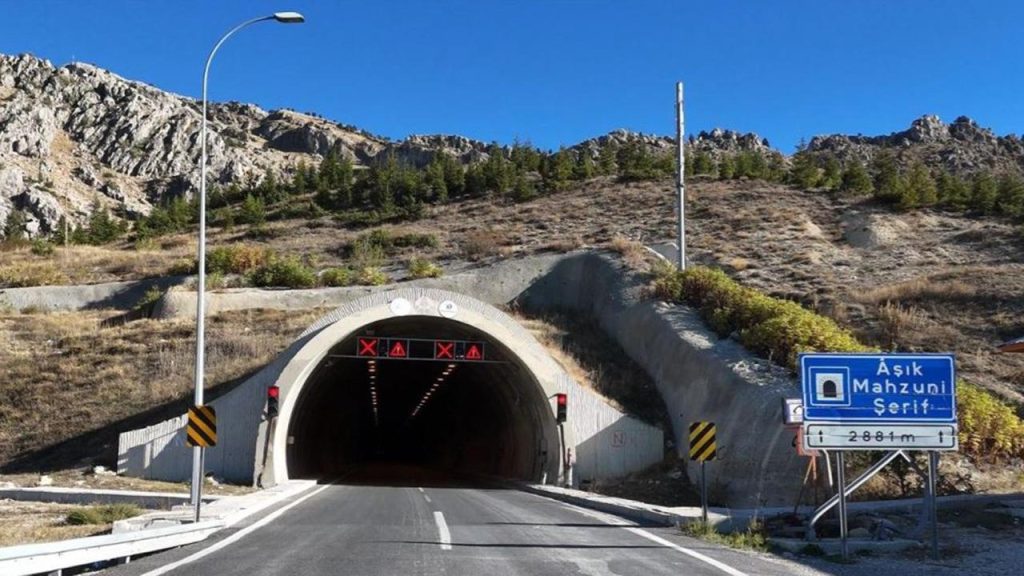Transportation and Infrastructure Minister Abdulkadir Uraloğlu reminded that in the 2,867-meter Aşık Mahzuni Şerif Tunnel on the Kahramanmaraş-Göksun road, there were small-scale damages during earthquakes centered in Kahramanmaraş. He emphasized that these damages were not at a level that would jeopardize traffic safety and therefore the tunnel continued to serve. Uraloğlu noted that it was anticipated that with the effect of aftershocks occurring over time, the tunnel could pose a risk in terms of life and property safety, which is why it was closed to traffic on August 28.
Uraloğlu indicated that they immediately started the necessary project and construction process to repair the damaged 30-meter section as part of the improvement works, saying, “We are now nearing the end of our work. We will open the tube of the Aşık Mahzuni Şerif Tunnel in the Göksun direction to traffic on November 7 at 3:00 pm. Until that date, we will continue to divert traffic from the old road through the Karagöz-Püren Pass-Değirmendere-Gölpınar-Göksun route. We plan to complete the works in the Kahramanmaraş direction by December 15.”
“Connects the Central Black Sea Coast and Central Anatolia to the Mediterranean ports”
Minister Uraloğlu stated that the Kahramanmaraş-Göksun road is a total of 64.1 kilometers long and on the route known as the “Literature Road,” there are 11 double-tube tunnels totaling 16,316 meters, 2 viaducts totaling 570 meters, 3 bridges totaling 145 meters, and 6 bridge intersections totaling 734 meters. Uraloğlu drew attention to the contributions that the works on the road will make to transportation, saying, “It connects the Central Black Sea Coast and Central Anatolia Region to the Mediterranean ports, Syrian border crossings, and Middle Eastern countries through Kahramanmaraş. By shortening the old 80-kilometer route to 64.1 kilometers, we have reduced the travel time from 80 minutes to 41 minutes. The tunnels and viaducts on the road are named after various literary figures, making the road also known as the ‘Literature Road’.”
The literary figures after whom the tunnels and viaducts are named include Ali Kutlay, Aşık Mahsuni Şerif, Hayati Vasfi Taşyürek, Abdürrahim Karakoç, Bahaettin Karakoç, Cahit Zarifoğlu, Alaeddin Özdenören, Akif İnan, Rasim Özdenören, Erdem Bayazıt, Nuri Pakdil, Sezai Karakoç, and Necip Fazıl Kısakürek. This naming connection between literature and infrastructure highlights the cultural significance of the road and the impact it can have on the region’s transportation and economy. Plans for the completion of works and the reopening of the Aşık Mahzuni Şerif Tunnel are part of the ongoing efforts to enhance transportation infrastructure in the region.
Overall, the updates on the Kahramanmaraş-Göksun road project and the repair works on the Aşık Mahzuni Şerif Tunnel underscore the government’s commitment to improving transportation infrastructure in the region. The planned reopening of the tunnel and the reduced travel times on the newly constructed route are expected to facilitate smoother and faster transportation connections between different regions and contribute to economic growth and development. The naming of the tunnels after literary figures also adds a cultural dimension to the project, highlighting the importance of literature and arts in shaping the identity of a place. The collaboration between infrastructure development and cultural recognition showcases a holistic approach to regional development and underscores the significance of investing in both physical and cultural infrastructure for the well-being and progress of a community.


